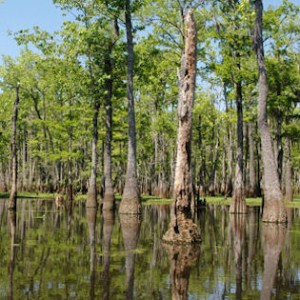 The cypress trees of Louisiana’s bayous (to continue Shift Journal’s venerable landscape metaphor tradition) are very well adapted to their natural habitat. They can get along just fine with most of their roots underwater; and they have a strong root system that can withstand powerful hurricanes despite their height and the swampy, sandy locations where they grow. They are often planted as conservation trees along the Gulf Coast.
The cypress trees of Louisiana’s bayous (to continue Shift Journal’s venerable landscape metaphor tradition) are very well adapted to their natural habitat. They can get along just fine with most of their roots underwater; and they have a strong root system that can withstand powerful hurricanes despite their height and the swampy, sandy locations where they grow. They are often planted as conservation trees along the Gulf Coast.
Sometimes they are grown as landscape trees in other parts of the country, and you can find them in many garden catalogs. If you wanted to grow a cypress tree in Midwestern clay soil, for instance, you might improve the planting site by mixing peat moss and sand into the soil, and you might water your cypress tree more often than some of your other landscape plants. Assuming that you had a reasonably good understanding of its needs, a cypress tree would probably grow quite well and would be a handsome addition to your yard.
Dr. Thomas Armstrong, Ph.D., an educator who recently wrote a book on neurodiversity, made a similar ecological analogy in his well-known article Special Education and the Concept of Neurodiversity, in which he compared children with special needs to rare flowers with particular environmental needs. Others have elaborated upon this comparison by suggesting that unlike these rare flowers, most children are like dandelions, able to grow almost anywhere.
It’s not really accurate, however, to say that dandelions grow almost anywhere. While those of us who find dandelions cropping up in our yards every spring might be forgiven for making that assumption, there are in fact wide swaths of Planet Earth that are not at all welcoming to dandelions—such as jungles, rainforests, deserts, frozen tundra, and swamps.
Indeed, in landscapes untouched by civilization, dandelions would rarely be found even in temperate parts of the world because they usually would be crowded out and overshadowed by larger vegetation. But the dandelion is an opportunistic weed that has made itself very much at home in landscapes altered by humans. It thrives in lawns, vacant lots, grassy areas along highways, and other such areas that would not exist in the absence of human activity. As such, it gives the impression of being a typical and highly adaptable form of plant life, simply because we often find it in our environment.
Evolution, by its very nature, works against the existence of species that can flourish anywhere. The farther a plant or animal ranges beyond its original habitat, the more vulnerable it becomes to catastrophic events such as disease or climate change. The hardiest species often are those that have precisely adapted to a specific environmental niche over millions of years. When it seems as if we can find a particular plant, animal, or neurological configuration anywhere we look, that’s probably not because it is ideally adapted to a wide variety of settings but because our society has made significant changes to the natural environment.
I wouldn’t describe this as not seeing the forest for the trees, as the old saying goes; rather, what’s being seen are the dandelions in the clearing where the trees were cut down.
Gwen McKay on 09/22/10 in Evolution, featured | 3 Comments | Read More
Comments (3)


Wonderful post, Gwen! The myth of “typical” really needs to be debunked. Over, and over, and over….
Thanks Rachel!
Anyone who sits on a horse for any reason should be wearing
appropriate protective horse riding gear. This is where the
need for a good horse racing systems comes in. Several of the rocking horse pozycjonowanie stron plans include things
like steel hardware and slats that could pose difficulties for younger youngsters.
My page: american paint horse association registration number - Chance,